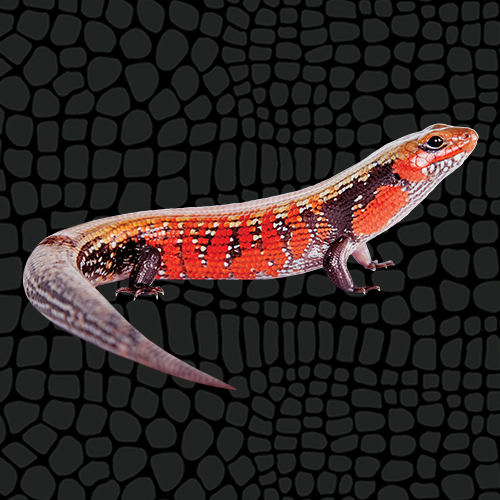African Fire Skink
A Terrestrial Gem
Renowned for its bright and vivid colors, the fire skink is considered one of the most beautiful species of skinks. These lizards have a golden-bronze dorsal and red, black, orange, and white lateral stripes, bars and flecking. Their color may lighten or darken based on their mood. These skinks can often be regarded as shy but once they have time to settle into their new environment, they will start to be more active and investigate their surroundings. Unlike most other skinks, this species lays eggs. The fire skink has become quite popular as a pet due to their interesting habits along with their shy and mild temperament.
Habitat
The fire skink is indigenous to the tropical rainforests of western Africa and primarily live in open woodlands, at the edge of open grasslands and rainforests. These skinks are primarily terrestrial species because they spend the majority of their time on the ground. Sometimes they can also be found near ponds and lakes when their skin is shedding. They are the most active during the day but feel safest while hiding in burrows.
Housing
Housing must be sealed and escape proof. Hatchling fire skinks can be housed in a 15 gallon Zilla Critter Cage but adults require a minimum of a 40 Breeder Zilla Critter Cage, especially for a pair of skinks. Provide these skinks with substrates that enable burrowing such as Zilla Jungle Mix or Bark Blend. Provide a hide box and artificial foliage, driftwood, rocks, or logs for ample basking and hiding opportunities. The Zilla Rock Lair is an ideal hiding space for your skink to cool down. For moisture, provide a bowl or dish of fresh water 2-3 times per week. Misting once to twice daily will also help maintain the humidity at around 60-70%.
Temperature and Humidity
It’s important to create a thermal gradient (or a warm and cool side) in the cage/enclosure. This can be done with an appropriate sized Zilla Heat Mat adhered to the bottom of the tank all the way to one side and add proper lighting. Ideal temperatures for fire skinks range from 80-85°F on the cool side and 90-95°F on the warm, basking side. These skinks require UVA/UVB fluorescent lighting to thrive. Using the Low Profile Dual Fixture with a 50W Day Blue Mini Halogen Bulb and a Desert Mini Compact Fluorescent UVB Bulb will provide the correct heat and UV for your fire skink. Spot clean the enclosure for urates, feces, or uneaten food at least twice per week. Be sure to periodically replace the substrate, clean, and disinfect the enclosure and its furnishings at least every 2-3 months.
Feeding and Diet
In the wild, fire skinks are omnivorous, meaning they will eat both plant and animal matter. In captivity, feed your skinks an assortment of crickets, mealworms, superworms, roaches, and waxworms every other day. Feeder insects should be fed Zilla Gut Load Cricket and Insect Food and given Zilla Gut Load Cricket Drink. By feeding these products you will increase the nutritional value of your feeders and help pass important nutrients on to your fire skinks. They may eat pinky mice as well, but feed them sparingly, if at all. When feeding spray the insects with Zilla Calcium Supplement and Vitamin Supplement Sprays 1-2 times weekly for additional calcium and vitamin D3. Supplementing calcium is necessary in order to prevent metabolic bone disease.
Handling
African Fire skinks can become very accustomed to regular human interaction and can even be hand fed. Many can be handled for short periods of time, but are often fast moving and are a flightier species. Care should therefore be taken to not accidently drop these animals when handling them. Do not grab your skink by its tail. This may cause the tail to detach because you may be perceived as a predator.
Be sure to wash your hands after handling any reptiles.


